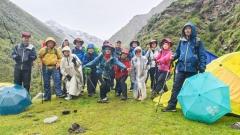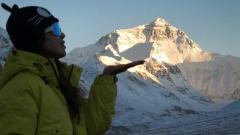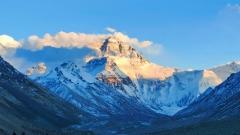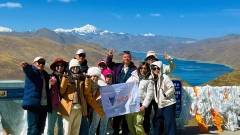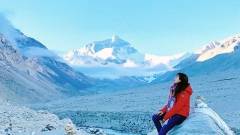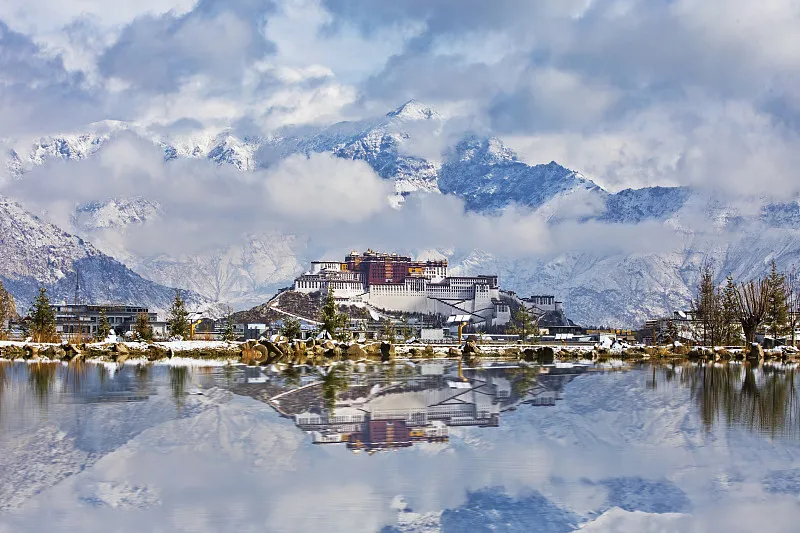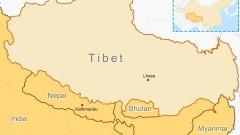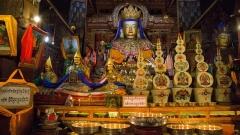Lhasa sits on the Tibetan Plateau at roughly 3,650 meters (about 11,975 feet) above sea level and is one of the highest capital cities on Earth. That high elevation shapes everything you’ll experience here — the thin, oxygen-reduced air, the intense sun, the rhythm of daily life, and even how long and comfortably you can explore temples, markets and high lakes. For international tourists, the altitude is the single most important logistical and health consideration when planning a Tibet trip.
Why Lhasa’s Altitude Matters: Recognizing Altitude Illness
At high elevation air pressure is lower, so each breath supplies less oxygen than at sea level. Most healthy people feel the difference at about 2,500–3,000 m; at Lhasa’s elevation the effects are noticeable but usually manageable with cautious pacing. Common early symptoms include headache, shortness of breath during exertion, difficulty sleeping, decreased appetite and fatigue. These are usually temporary and improve with rest and a slow pace.
Two dangerous conditions — HAPE (high altitude pulmonary edema) and HACE (high altitude cerebral edema) — are rare for typical tourist routes if you ascend carefully, but they are serious when they occur. Severe breathlessness at rest, coughing up frothy sputum, confusion, and difficulty walking in a coordinated way are emergency signs. If those appear, immediate descent and medical help are essential.
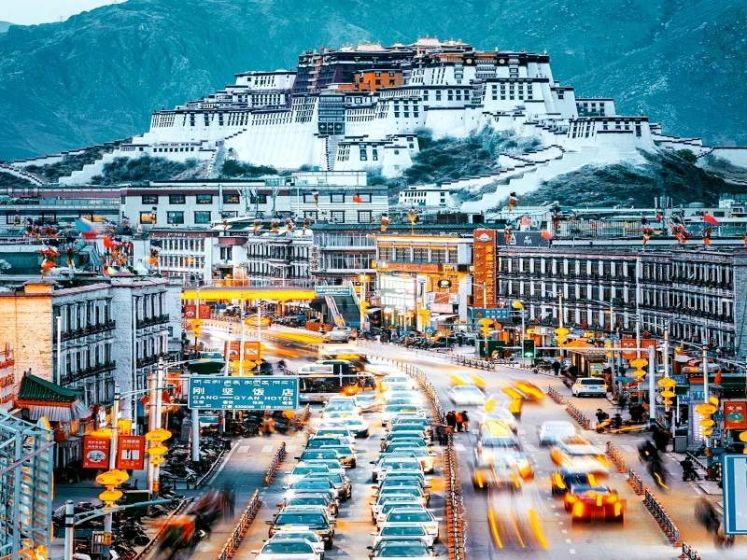
Lhasa
The Different Altitude Of The Main Districts Of Lhasa
Chengguan (Central Lhasa)
Chengguan is the city center where most hotels, restaurants and major temples (Jokhang, Barkhor) are located. The elevation is roughly 3,650 m, which makes it the primary base for acclimatization on arrival. Because Chengguan sits in a river valley plain, it feels slightly less exposed than higher slopes, and many visitors find they can adjust here in two to three days.
Doilungdêqên (Duilongdeqen)
To the west of Chengguan, average altitudes rise — parts of this district average about 4,500 m — and important sites such as Tsurphu Monastery sit high (around 4,300 m). Avoid scheduling demanding day hikes here on arrival day. If you want to visit this district, build up 48–72 hours of acclimatization in Chengguan first.
Damxung County (Namtso region)
Damxung’s average elevation is about 4,200 m and contains Namtso Lake (≈4,718 m). Namtso is spectacular but significantly higher than Lhasa; visiting Namtso is best done as an overnight trip after at least two or three days of steady acclimatization in the city.
Dagzê, Maizhokunggar and the Surrounding Counties
These eastern counties and small towns are mostly above 4,000 m, with notable sites like Ganden Monastery (≈3,800 m) set on mountain ridgelines. If you plan to tour multiple counties, schedule travel in order of lowest to highest altitude when possible.
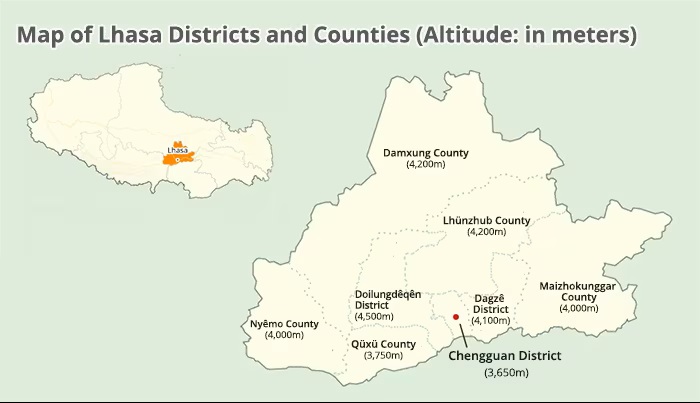
The Map of Lhasa City
The Altitudes of Major Attractions in Lhasa
Potala Palace (≈3,700 m)
The Potala Palace sits on Red Hill and requires climbing many staircases and narrow passages — a physically demanding visit even for those accustomed to moderate elevation. For this reason, many operators recommend visiting Potala on day 2 or 3 after arrival to allow the body to adapt. Take breaks on stair landings and move slowly.
Jokhang Temple & Barkhor Street (≈3,650 m)
Being in the central square, Jokhang and Barkhor are perfect first-day activities if you feel well enough for a short, slow walking tour. The area gives an immediate and accessible cultural immersion with less extreme climbing.
Sera and Drepung Monasteries (≈3,700–3,800 m)
Both are slightly higher than downtown and have hilly grounds. Sera’s famous afternoon monk debates are a cultural highlight — a short visit to observe is generally fine within the first 48 hours, as long as you avoid strenuous walks uphill.
Ganden Monastery (≈3,800 m)
Ganden sits outside Lhasa on higher terrain; the approach includes winding mountain roads. Many travelers visit Ganden after at least three days in Lhasa. The scenery is spectacular, but the journey is longer and the altitude is higher, so keep the pace slow.
Namtso Lake (≈4,718 m)
Namtso is breathtaking — a clear, high saline lake encircled by snow-topped mountains — but its altitude is much higher than Lhasa’s. Many visitors feel significant breathlessness or fatigue here if they attempt the roundtrip in a single day. Overnight stays near the lake or a two-day itinerary are recommended for safety and enjoyment.
Yamdrok Lake (≈4,441 m)
Yamdrok is closer to Lhasa than Namtso and often visited as a day trip. Still, its higher elevation and exposed viewpoints require caution: walk slowly and allow time for rest if you feel short of breath.
Gonggar Airport (≈3,570 m)
Flights will usually land at Gonggar (Lhasa Gonggar International Airport), which itself sits at high altitude. You’re often at airport elevation for an hour or more before you transfer to downtown Lhasa; this combined exposure to high air pressure change and the short drive into the valley makes gradual pacing on arrival even more important.
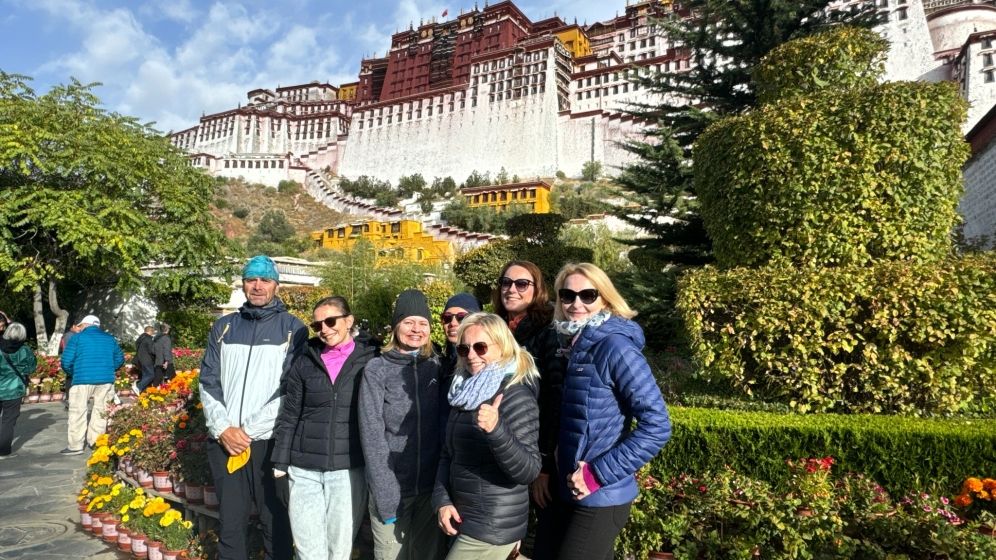
Potala Palace
How Lhasa Compares with other Tibetan destinations
Lhasa’s elevation (≈3,650 m) is high, but many famous Tibetan destinations are even higher:
| Destination | Altitude (meters) |
|---|---|
| Lhasa | 3,700 |
| Gyantse | 3,977 |
| Shigatse | 3,860 |
| Tingri | 4,300 |
| Everest Base Camp | 5,200 |
| Saga | 4,640 |
| Gyirong | 2,774 |
| Darchen | 4,670 |
| Mount Kailash | 6,714 |
| Lake Manasarovar | 4,590 |
| The Ruins of Guge Kingdom | 3,889 |
| Nyingchi | 3,000 |
| Tsedang | 3,560 |
| Chamdo | 3,200 |
Practical Health Tips & Preventive Measures at Lhasa
- Hydrate constantly. Drink more water than you think you need; mountain air is dry and dehydrates quickly.
- Eat light, carbohydrate-focused meals. Carbs are easier to metabolize when oxygen is limited.
- Sleep early and get adequate rest. Avoid stimulants and alcohol for the first 48–72 hours.
- Move slowly and breathe deeply. Walk at an easy pace; exaggerated short steps and shallow breathing increase fatigue.
- Consider medication only after consulting a doctor. Acetazolamide (Diamox) is commonly used under medical guidance; don’t self-prescribe.
- Carry simple oxygen aids when available. Many hotels and tour vehicles offer small oxygen canisters or concentrators — useful for transient relief but not a substitute for descent if symptoms worsen.
- Know emergency symptoms. If breathlessness at rest, severe coughing (especially spitting frothy sputum), sudden confusion or difficulty walking appear, descend immediately and seek medical help.
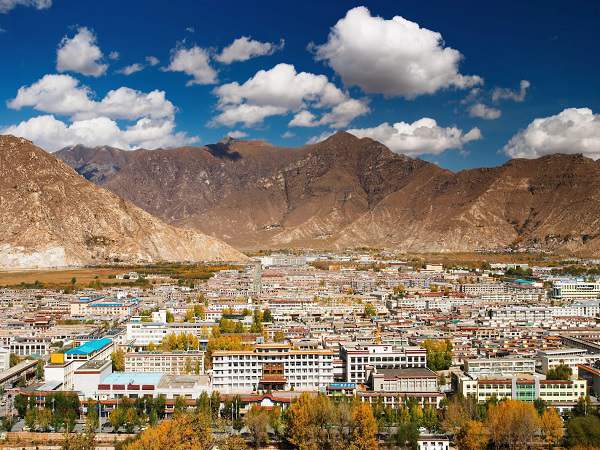
Lhasa City
Frequently Asked Questions about Lhasa
Q: Can seniors or children travel to Lhasa?
A: Many do, but medical checks are recommended and travel should be paced very conservatively. Consult a physician and plan extra rest days.
Q: Is supplemental oxygen necessary?
A: Not for most healthy travelers in Lhasa, but having access to oxygen or oxygen canisters for temporary relief can be useful — especially on higher day trips.
Q: What if I get altitude sickness?
A: For mild symptoms, rest and slow movement usually help. For severe symptoms (breathlessness at rest, confusion), descent and immediate medical attention are required.
Are you ready to travel to Lhasa?
Lhasa’s elevation is both a challenge and a reward. The city’s thin air, blue skies and radiant sunlight create a vivid setting for temples and culture that few other places can match — but they call for thoughtful planning. With gradual acclimatization, conservative pacing, and respect for your body’s signals, Lhasa becomes not only accessible, but deeply enjoyable.
If you want a stress-free, altitude-aware itinerary, consider booking with a local operator experienced in acclimatization logistics. China Dragon Travel specializes in culturally rich, well-paced Lhasa itineraries that prioritize health and respectful access to sacred sites. We can arrange comfortable transfers from Gonggar Airport (≈3,570 m), book Potala Palace time slots, plan overnight Namtso stays to reduce altitude shocks, and provide local guides who explain both the physical altitudes and the spiritual heights of Tibet — so you can focus on the experience rather than the logistics.



